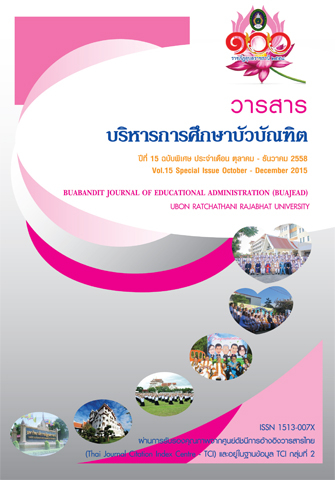การศึกษาและพัฒนาความมุ่งมั่นในการเรียนของนักศึกษาระดับปริญญาตรี สาขาการศึกษาปฐมวัย
Main Article Content
บทคัดย่อ
การวิจัยครั้งนี้มีวัตถุประสงค์เพื่อศึกษาและพัฒนาความมุ่งมั่นในการเรียนของนักศึกษาระดับ ปริญญาตรีสาขาการศึกษาปฐมวัย โดยวิเคราะห์องค์ประกอบความมุ่งมั่นในการเรียนของนักศึกษา สร้าง รูปแบบฝึกอบรมและพัฒนาความมุ่งมั่นในการเรียนของนักศึกษาโดยใช้รูปแบบฝึกอบรมแบบ 4A กลุ่มตัวอย่าง ที่ใช้ในการวิจัยเป็นนักศึกษาระดับปริญญาตรีสาขาการศึกษาปฐมวัยในมหาวิทยาลัยราชภัฏกลุ่มภาคเหนือ ตอนบน ได้กลุ่มตัวอย่างในการศึกษาองค์ประกอบความมุ่งมั่นในการเรียน จำนวน 595 คน ซึ่งได้มาจากการสุ่ม แบบแบ่งชั้น กลุ่มตัวอย่างที่ใช้ในการพัฒนาความมุ่งมั่นในการเรียนของนักศึกษา จำนวน 2 หมู่เรียน ได้จาก การเลือกแบบเจาะจง แบ่งเป็นกลุ่มทดลอง จำนวน 30 คน ได้รับการฝึกอบรมเพื่อพัฒนาความมุ่งมั่นในการเรียน และกลุ่มควบคุม จำนวน 33 คนได้รับการจัดกิจกรรมตามปกติของทางมหาวิทยาลัย เครื่องมือที่ใช้ คือ แบบวัด ความมุ่งมั่นในการเรียนของนักศึกษาระดับปริญญาตรีสาขาการศึกษาปฐมวัยและรูปแบบฝึกอบรมแบบ 4A เพื่อพัฒนาความมุ่งมั่นในการเรียน
ผลการศึกษาวิจัยสรุปได้ดังนี้ 1) ผลการวิเคราะห์องค์ประกอบเชิงสำรวจ พบว่า แบบวัดความมุ่งมั่น ในการเรียนของนักศึกษามี 3 องค์ประกอบ ได้แก่ เจตคติต่อการเรียน มี 6 ตัวบ่งชี้ แรงจูงใจในการเรียน มี 4 ตัวบ่งชี้ และพฤติกรรมการเรียน มี 5 ตัวบ่งชี้ ส่วนผลการวิเคราะห์องค์ประกอบเชิงยืนยันพบว่า ทั้งโมเดลการวัด องค์ประกอบเดี่ยวและโมเดลการวัดหลายองค์ประกอบมีความเหมาะสมพอดีกับข้อมูลเชิงประจักษ์ 2) ผลการสร้าง รูปแบบฝึกอบรมได้รูปแบบฝึกอบรมแบบ 4A ประกอบด้วย ขั้นการสร้างบรรยากาศ ขั้นการเรียนรู้จากการปฏิบัติ ขั้นการวิเคราะห์ และขั้นการนำไปประยุกต์ใช้ ซึ่งมีคุณภาพในระดับเหมาะสมมาก และ 3) ผลการพัฒนาความมุ่งมั่น ในการเรียนของนักศึกษาพบว่า รูปแบบฝึกอบรมแบบ 4A สามารถพัฒนาความมุ่งมั่นในการเรียนของนักศึกษา โดยมีคะแนนหลังการทดลองสูงกว่าก่อนทดลองและสูงกว่าคะแนนนักศึกษาในกลุ่มควบคุมอย่างมีนัยสำคัญทางสถิติ ที่ระดับ .01 ทั้งโดยรวมและรายด้าน โดยมีขนาดส่งผลต่อคะแนนรวมระดับมากและมีขนาดส่งผลต่อคะแนน รายด้านทุกด้านระดับมาก
The Study and Development of the Student Engagement of Bachelor Degree Students in Early Childhood Education Program
The main purposes of this research were to study and compare the Student engagement of Bachelor Degree students in Early Childhood Education Program through the factor analysis of Student Engagement; to develop a training program; and to develop the Student engagement by using a 4A training program. The sample used in the study was the Bachelor Degree students in Early Childhood Education Program of Rajabhat Universities in the upper northern region. The sample for the factor analysis of Student Engagement was 595 students selected by stratified random sampling. The sample used for the development of Student engagement was two groups of students selected by purposive sampling. The experimental group of 30 students was trained for the development of Student Engagement while the control group of 33 students was scheduled with normal learning activities provided by the university. The instruments used were an assessment form for the Student Engagement of Bachelor Degree students in Early Childhood Education Program and a 4A training program.
The results of the research were summarized as follows: 1) the exploratory factor analysis found that the assessment form for Student Engagement consisted of three factors. They were Learning Attitude with six indicators, Learning Motivation with four indicators and Learning Behavior with five indicators. The confirmatory factor analysis revealed that both measurement models of single factor and multiple factors fit the empirical data. 2) For the development of a training program, a 4A training program was obtained. The program comprised 4 steps: Atmosphere, Active Learning, Analysis, and Applications; with the quality at the very appropriate level. 3) Regarding the development of Student Engagement, it was found that the 4A training program could make the students’ scores after the experiment higher than those of before the experiment and also those of the control group of students with the statistical significance at the level of 0.01, both in general and in individual areas. The effect size of the total score was at the high level and of the scores in individual areas was at the high level.

